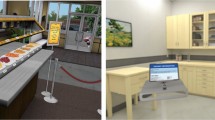Abstract
One aim of virtual reality technology is to immerse the user in a digital environment that is distinct from physical reality. Feeling spatially located in this digital environment is central to the experience and is more formally known as spatial presence. Experiences of spatial presence differ between individuals; prominent theories assume that these differences may, in part, be explained by differences in more general spatial abilities. Whilst there is some support for this claim with desktop systems, there is currently no direct empirical evidence to support this with more immersive technologies such as head-mounted displays (HMDs). In this study, participants completed three different measures of spatial ability before experiencing two virtual environments. These measures included a self-report of visuospatial imagery; the mental rotations test; and a test of topographical memory. After completing the measures, participants briefly experienced a virtual city and a virtual train ride through a HMD. The user’s head movements were tracked, and visual displays were updated to give the sense of a full 360° environment. After each experience, the participants reported how present they felt and the extent to which they had a mental model of the environment. Self-reports of imagery were positively correlated with reports of spatial presence, consistent with the previous literature. However, spatial presence was not related to performance on either of the more objective tests. Whilst this provides confirmatory evidence that self-reports of imagery can predict presence, it is still unclear which more basic spatial abilities, if any, could underlie this relationship.




Similar content being viewed by others
References
Alsina-Jurnet I, Gutiérrez-Maldonado J (2010) Influence of personality and individual abilities on the sense of presence experienced in anxiety triggering virtual environments. Int J Hum Comput Stud 68:788–801. doi:10.1016/j.ijhcs.2010.07.001
Bland M (2000) An introduction to medical statistics, 3rd edn. Oxford University Press, Oxford
Cummings JJ, Bailenson JN (2015) How Immersive Is Enough? A meta-analysis of the effect of immersive technology on user presence. Media Psychol. doi:10.1080/15213269.2015.1015740
Hartley T, Harlow R (2012) An association between human hippocampal volume and topographical memory in healthy young adults. Front Hum Neurosci 31:6. doi:10.3389/fnhum.2012.00338
Hartley T, Bird CM, Chan D, Cipolotti L, Husain M, Vargha-Khadem F, Burgess N (2007) The hippocampus is required for short-term topographical memory in humans. Hippocampus 17:34–48. doi:10.1002/hipo.20240
Hartmann T, Wirth W, Schramm H, Klimmt C, Vorderer P, Gysbers A et al (2016) The spatial presence experience scale (SPES). J Media Psychol 28:1–15. doi:10.1027/1864-1105/a00013
Hofer M, Wirth W, Kuehne R, Schramm H, Sacau A (2012) Structural equation modelling of spatial presence: the influence of cognitive processes and traits. Media Psychol 15:373–395. doi:10.1080/15213269.2012.723118
Kennedy RS, Lane NE, Berbaum KS, Lilienthal MG (1993) Simulator sickness questionnaire: an enhanced method for quantifying simulator sickness. Int J Aviat Psychol 3:203–220. doi:10.1207/s15327108ijap0303_3
Kosslyn SM (1994) Image and brain. MIT Press, Cambridge MA
Lee KM (2004) Presence, explicated. Commun Theory 14:27–50. doi:10.1111/j.1468-2885.2004.tb00302.x
Ling Y, Nefs HT, Brinkman WP, Qu C, Heynderickx IEJ (2013) The relationship between individual characteristics and experienced presence. Comput Human Behav 29:1519–1530. doi:10.1016/j.chb.2012.12.010
Lombard M, Ditton T (1997) At the heart of it all: the concept of presence.J Comput Mediat Commun 3. doi:10.1111/j.1083-6101.1997.tb00072.x
Minsky M (1980) Telepresence. Omni 2:44–52
Peters M, Laeng B, Latham K, Jackson M, Zaiyouna R, Richardson C (1995) A redrawn Vandenberg and Kuse mental rotations test-different versions and factors that affect performance. Brain Cognit 28:39–58. doi:10.1006/brcg.1995.1032
Steuer J (1992) Defining virtual reality: dimensions determining telepresence. J Commun 42:73–93. doi:10.1111/j.1460-2466.1992.tb00812.x
Vandenberg SG, Kuse AR (1978) Mental rotations, a group test of three-dimensional spatial visualization. Percept Motor Skill 47:599–604. doi:10.2466/pms.1978.47.2.599
Vorderer P, Wirth W, Gouveia FR, Biocca F, Saari T, Jäncke F et al (2004) MEC spatial presence questionnaire (MEC-SPQ): Short documentation and instructions for application. Report to the European Community, Project Presence: MEC (IST-2001-37661)
Wirth W, Hartmann T, Böcking S, Vorderer P, Klimmt C, Schramm H et al (2007) A process model of the formation of spatial presence experiences. Media Psychol 9:493–525. doi:10.1080/15213260701283079
Acknowledgments
We would like to thank Charlotte Elwell for all her technical support throughout the study, and we would like to thank all the participants for their time and willingness to participate.
Author information
Authors and Affiliations
Corresponding author
Ethics declarations
Conflict of interest
The authors declare that they have no conflict of interest.
Rights and permissions
About this article
Cite this article
Coxon, M., Kelly, N. & Page, S. Individual differences in virtual reality: Are spatial presence and spatial ability linked?. Virtual Reality 20, 203–212 (2016). https://doi.org/10.1007/s10055-016-0292-x
Received:
Accepted:
Published:
Issue Date:
DOI: https://doi.org/10.1007/s10055-016-0292-x




